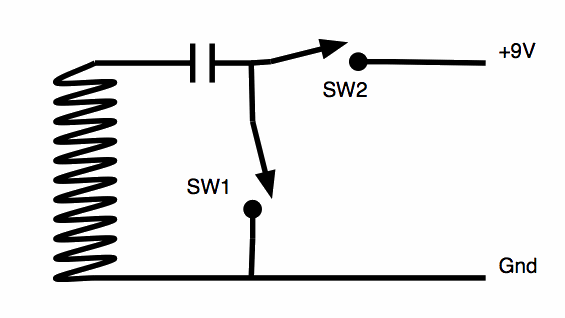Locally I can obtain an ANLY weekly programmable weekly timer for HK$360. Details of this unit can be found at:-
Thats still fairly expensive for what seems a fairly straightforward device.
Is your intended "fix" going to run from a 9V 216/PP3 battery, or something more substantial?
How many daily or weekly cycles are you anticipating?
In the next block of electronics I have to find a way of using the ON and OFF pulses to cause the solenoid to change polarity. A flip flop of some sort comes to mind, but which type?
David, I appreciate you trying to do this "the right way", but sometimes it only needs to be "good enough".
If you put a decent capacitor in series with the solenoid..... wait, let me draw it...

If the capacitor is lets say, 470uF, when you close SW2, you will get a pulse of current through the coil with + at the top end.
Leaving the switch closed makes little difference to current - it will taper off as the cap charges, eventually ending with virtually nothing.
Release SW2, and close SW1 and the capacitor will now discharge through the coil - with the opposite polarity!
Replace the switches with transistors, and you can get your "open" and "close" polarity pulses without ANY expensive driver chips, H-bridges and mucking about...
Or you could use a single-pole double-throw relay to achieve the same thing.
The timer and all other parts must suit DC 12 volt operation.
I just purchased a timer to replace a failed mechanical one to run my pool pumps. Cost me $8.99 AUD (including delivery). It runs on 220V AC (although they also have a 12V version), has a nice digital display and 16 programmable events over a week. Each event has selectable on and off times and days, including selecting the day, every-day, week-days, weekends, mon-sat etc - so highly selectable. OK, it doesn't have selectable output pulse width - but if you use the capacitor idea, you don't need it to.
Just my thoughts....